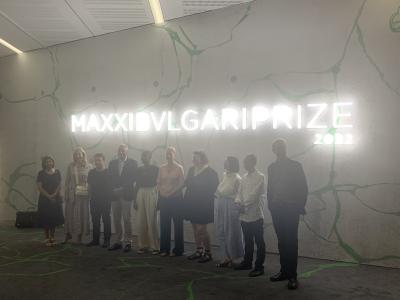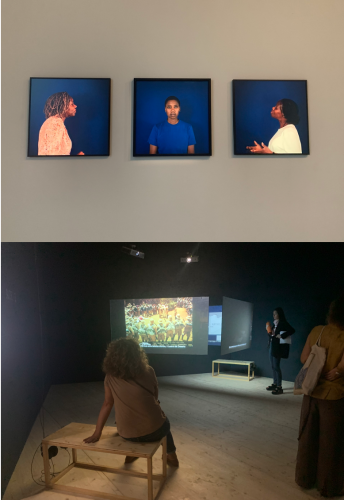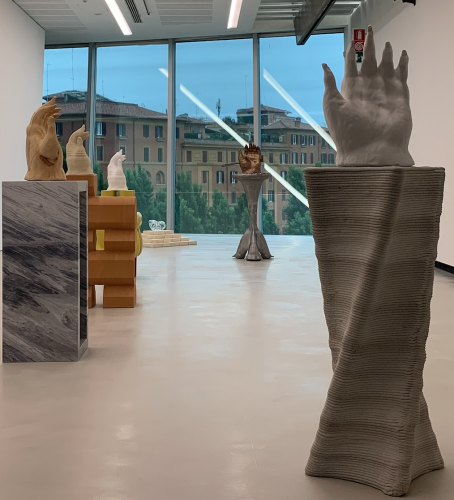MAXXI Bvlgari Prize 2022, finalists’ exhibition in full swing ahead of final

ROME – Alessandra Ferrini, Namsal Siedlecki and Silvia Rosi, the three finalists of the third edition of the MAXXI Bvlgari Prize 2022, exhibited their works for the first time on June 24 in gallery 5 of the museum of 21st century contemporary art and architecture. The exhibition is open to the public until November 2022.
The MAXXI Bvlgari Prize is a biennale award that provides a platform for young Italian artists to have their works launched onto the international scene. Curated by Giulia Ferraci and supported by the maison Bvlgari, the award seeks to assist young artists’ research from the creation of a work to the production of a catalogue and an exhibition.
Selected from a shortlist of artists by a jury of museum directors and curators, the three finalists are in competition for the winning prize which will be assessed in September 2022. The winner’s work will then be acquired by the museum and become part of its permanent collection.
The jury consists of Hou Hanru, Artistic Director of MAXXI, Bartolomeo Pietromarchi, Director of MAXXI Arte, Hoor Al Qasimi, President and Director Sharjah Art Foundation, Chiara Parisi, Director Pompidou-Metz and Dirk Snauwaert, Director WIELS Contemporary Art Centre. Chiara Parisi stressed the relevance of the three finalists’ works to the modern day with their “contemporary lenses” that tie together the past with the immediate present.
The jury maintained that the three finalists demonstrated “an urgency to imagine the future, addressing ecological issues through the transformation of matter, rethinking and redefining the question of cultural identity and geopolitical reality in relation to the consequences of colonisation and socio -cultural effects in the global context.”
“Each with their own language, Alessandra Ferrini, Silvia Rosi and Namsal Siedlecki speak to us about the relationship between man and nature, migration, identity, belonging, ideology, all urgent issues of our time,” explained Giovanna Melandri.
Alessandra Ferrini is an artist from Florence whose research is rooted in post-colonialism, Namsal Siedlecki lives and works in Seggiano, Tuscany and focuses much of his work on the relationship between man, technology and nature, and Silvia Rosi is a Togolese-Italian visual artist who focuses on the origins of identity, inspired by her Togolese heritage.
On the third floor of the MAXXI museum, in gallery 5, the exhibition opens with "Gaddafi in Rome: Notes for a Film," by Alessandra Ferrini, a video installation that takes a critical look at and retraces the historical and imperial significance of Muammar Gaddafi’s visit to Rome in 2009.
Immersing the spectator in a dark room with headphones and the three screens, the work deconstructs the trajectory of Gaddafi’s trip using the time markers of reportings from Italian newspaper, La Repubblica. Tackling the implications of the signing of the Treaty of Friendship, Partnership and Cooperation between Italy and Libya in 2008, and of Gaddafi’s lapel badge depicting Libyan anti-colonial hero Omar Al-Mukhtar when he disembarked the plane in Ciampino, Ferrini highlights an “emphasis on closure that seems to contradict Al-Mukhtar’s photograph.” She shows Berlusconi’s 2009 speech on colonial reparations that she tells was “hidden by Italian mainstream media” and labels his language that focuses on the closure of this chapter of history as “avoidant,” failing to sincerely address the decades of pain inflicted on the Libyan people during Italy’s colonial reign. Ferrini’s work combines different media and intertwines the artistic with factual, tackling Italy’s difficult relationship with its colonial past, the role of the media and its speculation of complex geopolitical events, and the significance of Gaddafi’s visit to Italy in just three acts.
Next in the gallery, is the work of Namsal Siedleckl who exhibits "Nuovo Vuoto." A work of six sculptures of a human hand that evokes the gradual evolution of the relationship between the human species, technology, and nature. Siedleckl started by digesting the cavity of a bronze hand purchased online and made six different sculptures in plaster and cement, Cirmolo wood, sandstone, and polyurethane to represent the trajectory between primordial man and modern man’s developments and rampant exploitation of nature. The choice of the hand as the symbolic centre of the piece conveys man’s intervention in technology, nature, artificial intelligence, and the journey from sculpture one to six highlights the need to find an equilibrium in amongst this.
The exhibition concludes with the work of Silvia Rosi, who tackles the implications of colonialism on language and identity. "Teacher Don’t Teach Me Nonsense" (2022) came after the Italian-Togolese artist’s trip to Togo to learn Ewe and Mina, the main local languages used by the Germans to evangelise the country and then banned during the French colonial era. The work combines a series of photographs, moving images and videos which seek to address her family’s heritage and cultural identity. Each piece brings the spectator on the trajectory of her journey of rediscovering her roots by recovering her family's native language. The series highlights the power of language within the origins of identity and cultural heritage, and Rosi attempts to find herself within this. The significance of rediscovering her family’s native language is tied up with West African history and colonial policies. Her works, in a mixture of black and white, still and moving, come together to bring the culture and rituals of her ancestors into her present world, as she often photographs herself in the middle.
al


© COPYRIGHT ITALIAN INSIDER
UNAUTHORISED REPRODUCTION FORBIDDEN


